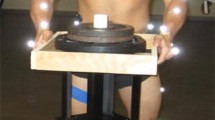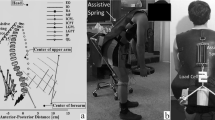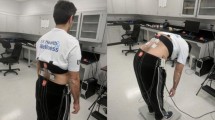Abstract
Functional asymmetry is among the multitude of risk factors for low-back pain (LBP), the most common injury under general industrial and agricultural conditions. However, previous studies showed that normal healthy individuals exhibit some functional asymmetry, indicating that not all asymmetry causes LBP. Therefore, the threshold value that is able to discriminate between normal and pathological situations is used as critical information to predict LBP. As a preliminary study to find threshold, the purpose of this study is to quantify the magnitude of bilateral asymmetries of erector spinae muscle forces of a healthy group during sagittally symmetric lifting. Ten healthy male subjects with no history of back pathology participated in this study, which collected motion capture, force data, and electromyography signals from six infrared cameras (MCam2, Vicon), two force platforms (AMTI), and surface EMG (BME Korea). In order to quantify the magnitude of bilateral asymmetry in the trunk muscle forces, we used 3D linked segment and EMG-assisted modeling approaches, both of which were verified based on their recapitulation of previously-proposed models. The results indicated that each muscle force in the lumbar region exhibited asymmetry during the entire lifting process. In particular, the erector spinae muscle forces exhibited an approximate 24% difference between bilateral sites (p<0.05). The results of this study provided data from normal individuals by which to identify pathological situations and predict LBP incidence within general industrial and agricultural conditions.
Similar content being viewed by others
References
F. Biering-Sorensen and C. Thomsen, Medical, social and occupational history as risk indicators for low-back trouble in a general population., Spine 11 (1986) 720–725.
M. Miyamoto, Y. Shirai, Y. Nakayama, Y. Gemben and K. Kaneda, An Epidemiologic Study of Occupational Low Back Pain in Truck Drivers., J. Nippon Med. Sch. 67(3) (2000) 186–190.
G. Waddel, The clinical course of low back pain. In: Waddell G, editor. The back pain revolution. 1st edition, Edinburgh: Churchill Livingstone, (1998) 103–117.
C. Leech, The Renaissance Project. Preventing chronic disability from low back pain. Ireland: Department of Social and Family Affairs. Government Publication (2004).
D. McMullin, T. Stobbe, S. Bang, D. Goddard, B. Han, R. Simmers, D. Fisher, A. French, D. Toothman and G. Middleton, Asymmetric loading on the body during symmetric lifts., In: Bittner, A. C., Champney, P. C. (Eds.), Advances in Industrial Ergonomics and Safety VII. Taylor & Francis, London, (1995) 719–725.
Bureau of Labor Statistics, Lost-Worktime Injuries and Illness: Characteristics and Resulting Time Away from Work, (2002) USDL04-460. US Department of Labor, Washington, D.C.
S. McGill, Low Back Disorders: Evidence-Based Prevention and Rehabilitation. Human Kinetics, Champaign (2002).
J. Knapik, C. Bauman, B. Jones, J. Harris and L. Vaughan, Preseason strength and flexibility imbalances associated with athletic injuries in female collegiate athletes, American Journal of Sports Medicine 19 (1991) 76–81.
J. Orchard, J. Marsden, S. Lord and D. Garlick, Preseason hamstring muscle weakness associated with hamstring muscle injury in Australian footballers, American Journal of Sports Medicine 25 (1997) 81–85.
T. Tyler, S. Nicholas, R. Campbell and M. McHugh, The association of hip strength and flexibility with the incidence of adductor muscle strains in professional ice hockey players, American Journal of Sports Medicine 29 (2001) 124–128.
K. Soderman, H. Alfredson, T. Pietila and S. Werner, Risk factors for leg injuries in female soccer players: a prospective investigation during one out-door season, Sports Medicine 9 (2001) 313–321.
R. Trivers, J. T. Manning, R. Thornhill, D. Sihgh and M. McGuire, Jamaican symmetry project: longterm study of fluctuating asymmetry in rural Jamaican children, Human Biology 71 (1999) 417–430.
E. Maupas, J. Paysant, A. M. Datie, N. Martinet and J. M. Andre, Functional asymmetries of the lower limbs. A comparison between clinical assessment of laterality, isokinetic evaluation and electrogoniometric monitoring of knees during walking, Gait and Posture 16 (2002) 304–312.
J. T. Manning and L. J. Pickup, Symmetry and performance in middle distance runners, International Journal of Sports Medicine 19 (1998) 205–209.
S. I. Subotnik, Limb length discrepancies of the lower extremity (the short leg syndrome). Journal of Orthopaedic & Sports Physical Therapy 3 (1981) 11–15.
J. M. Maines and R. F. Reiser, Ground reaction force bilateral asymmetries during submaximal sagittal plane lifting from the floor, International Journal of Industrial Ergonomics 36 (2006) 109–117.
D. A. Winter, Biomechanics and motor control of Human Movement, John Wiley & Sons, Inc. (1990).
I. Kingma, M. P. de Looze, H. M. Toussaint, J. G. Klijnsma and T. B. M. Bruijnen, Validation of a full body 3-D dynamic linked segment model, Human Movement Science 15 (1996) 833–860.
A. Plamondon, M. Gagnon and D. Desjardin, Validation of two 3-D segment models to calculate net reaction forces and moments at the L5/S1 joint in lifting, Clinical Biomechanics 11(2) (1996) 101–110.
A. R. Choi, Y. J. Kim, Y. H. Rim, T. G. Kang, K. K. Min, J. H. Bae, S. S. Lee, K. K. Lee and J. H. Mun, Development of a spine kinematic model for the clinical estimation of abnormal curvature, Proceedings of the World Congress on Medical Physics and Biomedical Engineering, (2006).
J. -H. Mun and D. -W. Lee, Three-Dimensional Contact Dynamic Model of the Human Knee Joint During Walking, KSME International Journal, 18(2) (2004) 211–220.
D. Gagnon, C. Lariviere and P. Loisel, Comparative ability of EMG, optimization, and hybrid modeling approaches to predict trunk muscle forces and lumbar spine loading during dynamic sagittal plane lifting, Clinical Biomechanics 16 (2001) 359–372.
W. S. Marras and K. P. Granata, The Development of an EMG-Assisted Model to Assess Spine Loading During Whole-Body Free-Dynamic Lifting, J. Electromyogr. Kinesiol. 7(4) (1997) 259–268.
K. P. Granata and W. S. Marras, An EMG-Assisted model of loads on the lumbar spine during asymmetric trunk extensions, Journal of Biomechanics 26(12) (1993) 1429–1438.
Author information
Authors and Affiliations
Corresponding author
Additional information
This paper was recommended for publication in revised form by Associate Editor Young Eun Kim
Ahn Ryul Choi received his B.S. and M.S. degrees in Bio-Mechatronic engineering from Sungkyunkwan University in 2005 and 2007, respectively. Ahn-Ryul Choi is currently a Researcher at the Bio-Mechatronics center and also a candidate in the biomedical Ph.D. program at Sungkyunkwan University, Korea. His research interests are in the area of digital human modeling and simulation.
Tae Sun Yun received his B.S. and M.S. degrees in mechanical engineering from Korea Aero-space University in 2005 and 2007, respectively. Tae-Sun Yun is currently a Researcher at the Bio-Mechatronics center and also a candidate in the biomedical Ph.D. program at Sungkyunkwan University, Korea. His research interests are in the area of digital human modeling and simulation.
Kyung Suk Lee is a specialist with many years experience of the agricultural health and safety in Republic of Korea. Her personal interests and most publications are in various hazards including ergonomic risk factors and management system set-up in local and national system. She has been doing her researches in National Academy of Agricultural Science (NIAST). She has also managed lots of network system that is composed of scientists, national officer, farmers union for agricultural safety and hearth. She is currently in the Group who is consultant with “safe farm model intervention” in local areas and national safety and health.
Kyoung Kee Min received his Ph.D degree Sungkyunkwan University in 2008. Dr. Min is currently a researcher at the Bio-Mechatronics Center in Sungkyunkwan University. Dr. Min’s research interests are in the area of disease classification using artificial neural network, digital human modeling & control.
Heon Hwang received his Ph.D. degree majoring in Engineering Science from the Louisiana State University, Baton Rouge in 1988. Dr. Hwang is currently a Professor at the Department of Bio-Mechatronic Engineering, Sung-kyunkwan University in Korea. Dr. Hwang’s research interests are intelligent motion control based on human motor and brain behavior, tele-operative biorobotic system and interface, and real time on-line bio-image processing and bio-sensing.
Ki Young Lee received a B.S., M.S. and Ph D. degree in Electronic Engineering from Myongji University in 1984, 1986 and 1992, respectively. Since 2004, he also has interested to study on Bioengineering, and finished the Ph D. course from Sungkyunkwan University. Dr. Lee is currently a Professor at the Department of Biomedical Engineering at Kwandong University in Kangneung, Korea. His research interests are the area of Bioelectronics and Bio-signal processing.
Euichaul Oh received a B.S. degree in Pharmacy (1983) and a M.S. degree in Physical Pharmacy (1985) from Seoul Nation University, respectively. He then acquired his Ph.D. degree in Pharmaceutics from the University of Iowa in 1996. Dr. Oh is currently a Chief Scientific Officer at the R&D Center of Kuhnil Pharm. In Seoul, Korea. He had worked at the pharmaceutical companies in USA as a Senior Research Scientist for 10 years. He is currently serving as an Editor Board of the Journal of Korean Pharmaceutical Sciences. Dr. Oh’s research interests are in the areas of Drug Delivery System, Physical and Industrial Pharmacy and Pharmaceutical Technology and Engineering.
Joung Hwan Mun received his Ph.D. degree majoring in mechanical engineering from the University of Iowa in 1998. Dr. Mun is currently a Professor at the Department of Bio-Mechat-ronic engineering at Sungkyun-kwan University in Suwon, Korea. He is currently serving as a director of the Bio-Mechatronics center with regard to an international IMS project. Dr. Mun’s research interests are in the area of digital human modeling, sports biomechanics, bio-electronics and digital factory for human oriented production system.
Rights and permissions
About this article
Cite this article
Choi, A.R., Yun, T.S., Lee, K.S. et al. Asymmetric loading of erector spinae muscles during sagittally symmetric lifting. J Mech Sci Technol 23, 64–74 (2009). https://doi.org/10.1007/s12206-008-1009-1
Received:
Revised:
Accepted:
Published:
Issue Date:
DOI: https://doi.org/10.1007/s12206-008-1009-1




